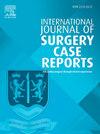A case report of dyspnea that revealed a congenital left cardiac diverticulum of discovery in adulthood with a fatal course
IF 0.6
Q4 SURGERY
引用次数: 0
Abstract
Introduction and importance
Congenital cardiac diverticula are rare malformations involving the myocardium, the endocardium, and occasionally the pericardium. They have variable presentations and are often incidental findings.
Case presentation
A 61-year-old man with no significant history presented worsening exertional dyspnea. Examination revealed obesity but was otherwise unremarkable. Initial tests were normal, but chest radiography showed cardiomegaly and ECG indicated diffuse microvoltage. Echocardiography revealed a large left ventricular diverticulum (7 × 8 cm) with a wide neck (4 cm) and severe dysfunction (EF 30 %). Coronary angiography confirmed normal coronary arteries. Despite intensive care, his condition deteriorated and required mechanical ventilation and vasoactive support. He underwent emergency surgery but succumbed intraoperatively.
Clinical discussion
Although rare, congenital cardiac diverticula can cause severe complications, including heart failure and sudden death. Echocardiography is the key to diagnosis, with CT or MRI providing further characterization. Surgery is the preferred treatment for symptomatic cases, while asymptomatic patients require close follow-up.
Conclusion
This case highlights the need for early diagnosis and timely intervention in congenital cardiac diverticula to prevent fatal outcomes.
求助全文
约1分钟内获得全文
求助全文
来源期刊
CiteScore
1.10
自引率
0.00%
发文量
1116
审稿时长
46 days

 求助内容:
求助内容: 应助结果提醒方式:
应助结果提醒方式:


